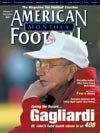AMERICAN FOOTBALL MONTHLY THE #1 RESOURCE FOR FOOTBALL COACHES
Article CategoriesAFM Magazine
|
Simple, Yet SophiscatedExpanding the 3-Level Concept with Lenoir-Rhyneby: Dan Gonzalez QB/WR Coach, Lenoir-Rhyne College © More from this issue In order to effectively overcome the myriad of problems presented by modern defenses, a complete passing game must possess both diversity and learnability. These two factors result in a highly sensitive balancing act for offensive coaches. The passing game must be able to attack a defensive structure on all levels, yet be learnable enough to yield a high degree of efficiency; the pass offense installed at Lenoir-Rhyne represents an attempt to simplify a sophisticated offense that incorporates easy learnability and diversity. The overall scheme utilizes multiple personnel groupings to go along with pre-snap movement; simplicity in teaching this system is of prime importance. Subscribe today!
|
|
|||||||
| HOME |
MAGAZINE |
SUBSCRIBE | ONLINE COLUMNISTS | COACHING VIDEOS |
Copyright 2025, AmericanFootballMonthly.com
All Rights Reserved





